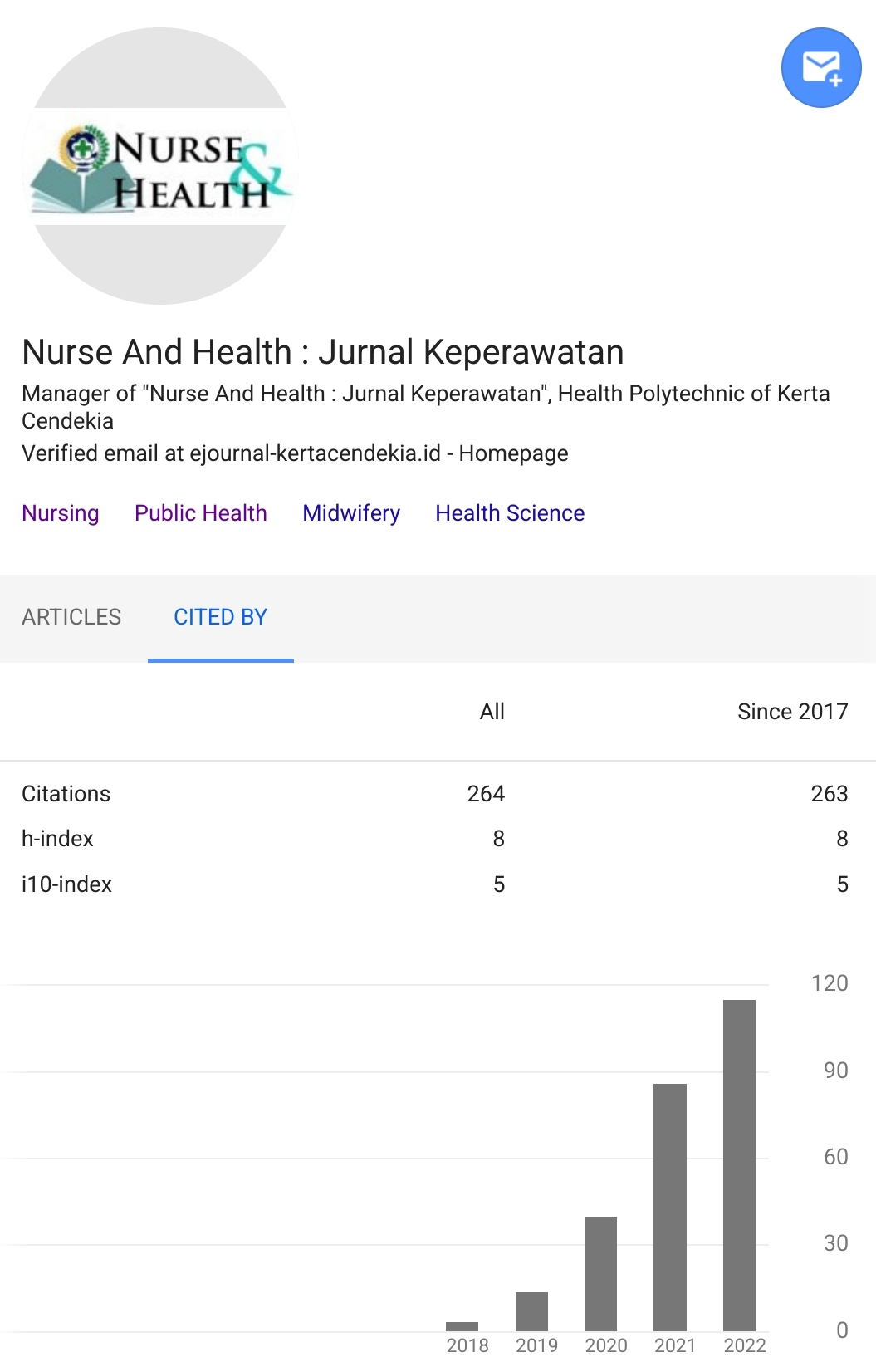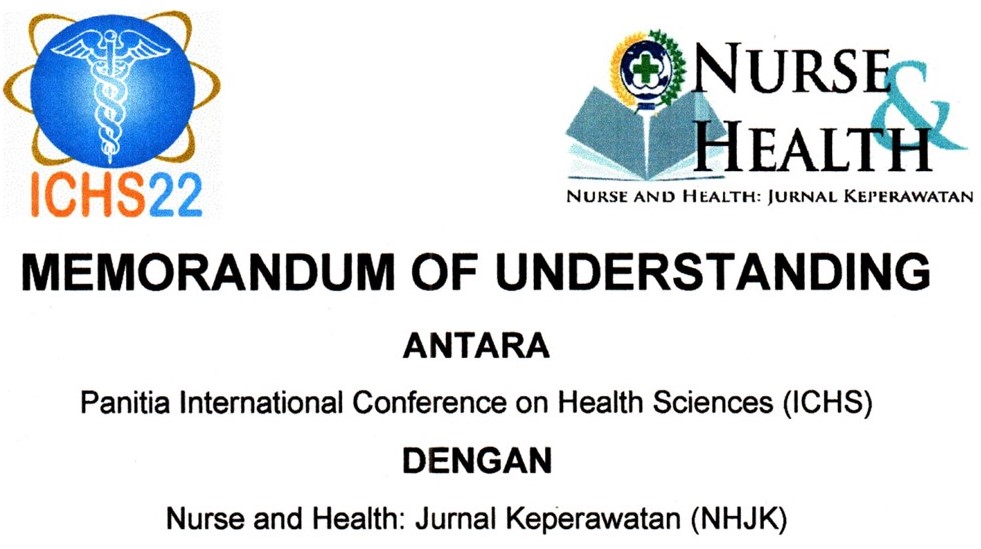MEASURING USABILITY TESTING BY THE ONLINE APPLICATION START EBNP QUESTIONNAIRE
Abstract
Background: Evidence-Based Nurse Practice (EBNP) is used to enhance the quality of nursing by considering internal evidence, external evidence, and patient assessment. In reality, applying EBNP has many problems such as knowledge level, lack of time, facilities, and management support such as training and seminar. The development of technology gives chances for the massive promotion of EBNP. Objective: This application is newly made and its pilot study aims at finding the answer to the usability and accessibility of online application START EBP. Design: This study used a cross-sectional study method. The target population in this study was 112 clinical nurses. The sampling technique used was purposive sampling. The sample size in the pilot study was 12 respondents. This research is a kind of research and development study. The new application is Online START EBP that uses seven levels of applying EBP. The data analysis carried out was usability test. Results: The results of 12 respondents selected from 112 populations by purposive sampling shows that the users are easier to learn and memorize the interface of the application START EBP in total averaged scored 3.24 point. The reliability results show an alpha value of 0.920, so the reliability is in the perfect category. Conclusion: The START EBP online application is easy to use because it is easy to understand by users.Downloads
References
Adnan, F., Prasetyo, B., & Nuriman, N. (2017). Usability testing analysis on the Bana game as education game design references on junior high school. Jurnal Pendidikan IPA Indonesia, 6(1), 88–94. Retrieved from https://doi.org/10.15294/jpii.v6i1.9597 DOI: https://doi.org/10.15294/jpii.v6i1.9597
Asiri, H., & Househ, M. (2017). The Use of Mobile Technologies in Nursing Education and Practice. Health Professionals’ Education in the Age of Clinical Information Systems, Mobile Computing and Social Networks. Elsevier Inc. Retrieved from https://doi.org/10.1016/B978-0-12-805362-1.00020-6 DOI: https://doi.org/10.1016/B978-0-12-805362-1.00020-6
Asmaul Husna & Budi Suryana. (2017). Metodologi Penelitian dan Statistik. (Prof. Dr. Asnah Said,Ed.). Jakarta: Pusat Pendidikan Sumber Daya Manusia Kesehatan KeMenKes RI.
Butler, K. D. (2011). Nurse Practitioners and Evidence-Based Nursing Practice. Clinical Scholars Review, 4(1), 53–57. Retrieved from https://doi.org/10.1891/1939-2095.4.1.53 DOI: https://doi.org/10.1891/1939-2095.4.1.53
Casman, C., Ahadi Pradana, A., Edianto, E., & Abdul Rahman, L. O. (2020). Kaleidoskop Menuju Seperempat Abad Pendidikan Keperawatan di Indonesia. Jurnal Endurance, 5(1), 115. Retrieved from https://doi.org/10.22216/jen.v5i1.4291 DOI: https://doi.org/10.22216/jen.v5i1.4291
Dame Elysabeth, Gita Libranty, S. N. (2015). Hubungan Tingkat Pendidikan Perawat Dengan Kompetensi Aplikasi Evidence Base Practice. Jurnal Skolastik Keperawatan, 1(1), 14–20. DOI: https://doi.org/10.35974/jsk.v1i01.22
Denise, F. Polit and Cheryl, Tatano, B. (2013). Essentials of Nursing Research Seventh Edition Appraising Evidence for Nursing Practice. Journal of Chemical Information and Modeling (Vol. 53). Retrieved from https://doi.org/10.1017/CBO9781107415324.004 DOI: https://doi.org/10.1017/CBO9781107415324.004
Hasugian, P. S. (2018). Perancangan Website Sebagai Media Promosi Dan Informasi. Journal Of Informatic Pelita Nusantara, 3(1), 82–86.
KEMENKES RI. PerMenKes no 40 Tahun 2017 Tentang Pengembangan Jenjang Karir Profesional Perawat Klinis, Pub. L. No. PMK no 40 tahun 2017, 72 (2017). Jakarta.
Ligita, T. (2012). Pengetahuan, Sikap dan Kesiapan Perawat Klinisi Dalam Implementasi Evidence-Base Practice. NERS Jurnal Keperawatan, 1, 83–95. DOI: https://doi.org/10.25077/njk.8.1.84-97.2012
Melnyk, B. M., & Fineout-Overholt, E. (2015). Making the Case for Evidence-Based Pratice and Cultiving a Spirit of Inquiry. Evidence-based practice in nursing and healthcare: a guide to best practice.
Nielsen, Jacob. (2017). Usability 101:Introduction to Usability. Retrieved from https://www.nngroup.com/articles/usability-101-introduction-to-usability/
Nielsen, Jakob. (1993). Usability Engineering. San Fransisco: Morgan Kaufmann. Retrieved from https://doi.org/10.1201/b16768 DOI: https://doi.org/10.1201/b16768
Pangetsu, H. (2014). Usability Testing of Virtual Keyboard. International Journal of Communication & Information Technology (CommIT) H, 8(1), 17–21. DOI: https://doi.org/10.21512/commit.v8i1.591
Rabiah, S. (2018). Penggunaan Metode Research and Development dalam Penelitian Bahasa Indonesia di Perguruan Tinggi. Asosiasi Dosen Bahasa Dan Sastra Indonesia (ADOBSI), (April 2015), 1–7. Retrieved from https://doi.org/10.31227/osf.io/bzfsj DOI: https://doi.org/10.31227/osf.io/bzfsj
Setyawati, A., Harun, H., Herliani, K., & Gerrish, M. (2017). Peningkatan pengetahuan perawat dan bidan tentang, 6(1), 53–56.
Staggers, N., & Thompson, C. B. (2002). The Evolution of Definitions for Nursing Informatics. Journal of the American Medical Informatics Association, 9(3), 255–261. Retrieved from https://doi.org/10.1197/jamia.M0946 DOI: https://doi.org/10.1197/jamia.M0946
Supriyatna, A. (2018). Penerapan Usability Testing Untuk Pengukuran. Jurnal Ilmiah Teknologi - Informasi Dan Sains (TeknoIS) Volume, 8(1), 1–16. DOI: https://doi.org/10.36350/jbs.v8i1.17
Tambuwun, T. F., Sengkey, R., Rindengan, Y. D. Y., Sam, T., & Manado, R. (2017). Perancangan Aplikasi Web Berbasis Usability. Jurnal Teknik Informatika, 12(1). Retrieved from https://doi.org/10.35793/jti.12.1.2017.17856
Thurstone, Gutman, L. S. (2018). Thurstone, Gutman, Likert Scale.
Copyright (c) 2021 Anggit Prasetyo Mituhu, Tri Nur Kristina, Luky Dwiantoro

This work is licensed under a Creative Commons Attribution-NonCommercial 4.0 International License.
Authors who publish with Nurse and Health: Jurnal Keperawatan agree to the following terms:
- Authors retain copyright licensed under a Creative Commons Attribution-NonCommercial 4.0 (CC BY-NC 4.0), which allows others to remix, tweak, and build upon the authors' work non-commercially, and although the others' new works must also acknowledge the authors and be non-commercial, they don't have to license their derivative works on the same terms.
- Authors are permitted and encouraged to post their work online (e.g., in institutional repositories or on their website) prior to and during the submission process, as it can lead to productive exchanges, as well as earlier and greater citation of published work (See The Effect of Open Access). Authors can archive pre-print and post-print or publisher's version/PDF.








_resize1.jpg)















